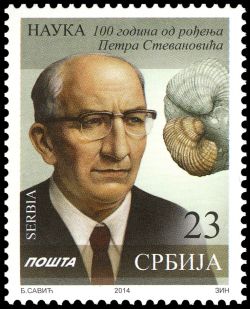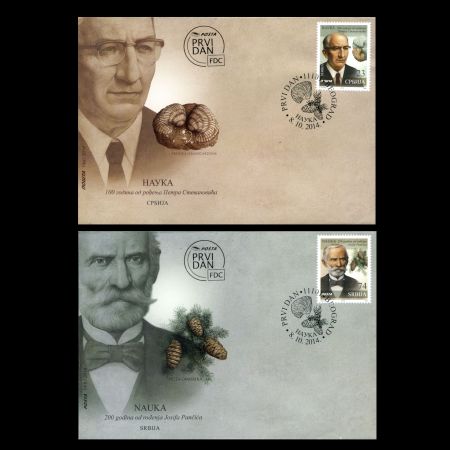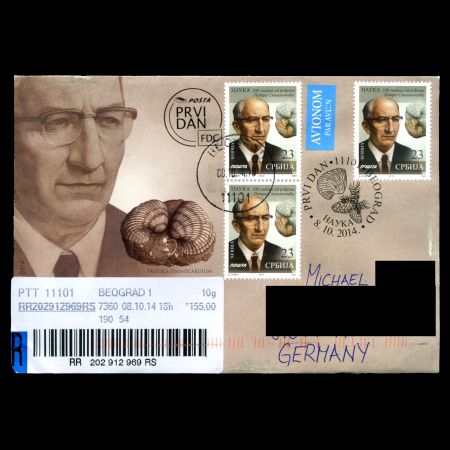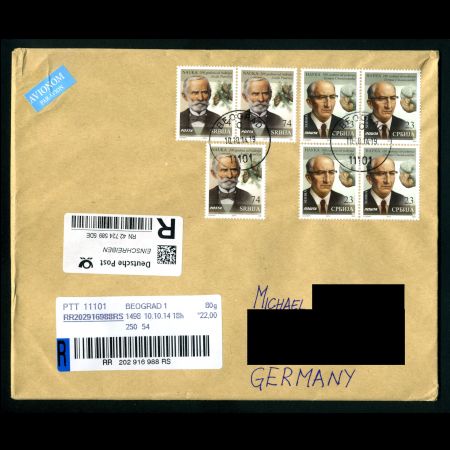PETAR STEVANOVIC
(1914–1999) , professor of geology at the University of
Belgrade,
member of the Serbian Academy of Sciences and Arts, president of the
Serbian Geological Society, and scientist with high international
reputation, is the last student of the prominent Serbian geologist
Jovan Žujović.
 His career began at the Natural History Museum in Belgrade in 1938, as
curator and the head of Geological and paleontological as well as
Mineralogical-petrological departments. The period of World War II
(1941-1945), he spent imprisoned in the Osnabruck labor camp, Germany.
Pedagogical and scientific activities commenced at the Faculty of
Philosophy in Belgrade in 1946. He defended his PhD thesis “The Lower
Pliocene of Serbia and neighboring areas” at the Moscow Paleontological
Institute (USSR) in 1948. He lectured the following subjects:
Introduction to independent geological-paleontological investigations,
Stratigraphy of Yugoslavia, the Quaternary geology. He was the author
of the textbooks: Historical Geology II-the Paleozoic Periods,
Historical Geology-the Cenozoic Periods and the Quaternary Geology.
His career began at the Natural History Museum in Belgrade in 1938, as
curator and the head of Geological and paleontological as well as
Mineralogical-petrological departments. The period of World War II
(1941-1945), he spent imprisoned in the Osnabruck labor camp, Germany.
Pedagogical and scientific activities commenced at the Faculty of
Philosophy in Belgrade in 1946. He defended his PhD thesis “The Lower
Pliocene of Serbia and neighboring areas” at the Moscow Paleontological
Institute (USSR) in 1948. He lectured the following subjects:
Introduction to independent geological-paleontological investigations,
Stratigraphy of Yugoslavia, the Quaternary geology. He was the author
of the textbooks: Historical Geology II-the Paleozoic Periods,
Historical Geology-the Cenozoic Periods and the Quaternary Geology.
In the field of Neogene stratigraphy of Pannonian Basen, he has
introduced the two new substages (time-intervals), the Portaferrian
(the Upper Pontian) and the Serbian (the Upper Pannonian) and
identified forty taxa, new for science (bivalve and gastropod species
and subspecies). During his long-lasting geological field research, he
discovered new fossiliferous localities of different geological age in
the Belgrade area, Kolubara Basin, Kostolac, Krupanj, Koceljeva,
Loznica and Timočka krajina. Good knowledge of several languages
(Russian, French, German) enabled him to follow successfully the
achievements in geosciences and to participate in many international
expert teams and committees. His first scientific article was issued in
1937, and up to 1999. he published more than 200 scientific and
professional papers. He was appointed as a member of the
Yugoslav Academy of Sciences and
Arts, the Slovenian Academy of Sciences and Arts, and the Academy of
Sciences of Bosnia and Herzegovina, as well as the honorary member of
the Hungarian Geological Society and the Paleontological Society of the
German Federal Republic. His successful and fruitful work has been
awarded by several orders and rewards (Order of Labor with the Golden
Wreath, two October Prizes of City of Belgrade, “Seventh July Prize”).
Owing to the great working capacity and self-discipline, he has
achieved excellent scientific outcomes and made significant
contributions to: developing and enhancing the geology school and
geological education in Serbia, teaching and training of generations of
geologists and paleontologists promoting and popularizing the geology
and geosciences; developing the museology, and conserving and
preserving the geological heritage of Serbia.
 Two fossilized
shells of shellfish Lymnocardium
sp. can be seen
on the top-right side of the stamps and on the FDC. These shells are
from fossil
collection of Petar Stevanovic, which is on display
at Geology
Department of the
Natural History Museum in Belgrade. This
collection includes
over 300.000 fossilized invertebrate remains, mostly of Tertiary
age,
from the territory of Balkans, Czech Republic, Austria, Hungary,
Romania, Italy and Iran. It was established in 1939 as a legacy of
Academy Member Petar Stevanovic (1914-1999), who spent first several
yeas of his long working life at the Natural History Museum. Best
represented group is of Neogene age
(up to 15 mya). Besides the
mollusks, this Collection also includes fossilized remains of other
invertebrate groups (trilobites and crinoids, several mya) as well as
microfauna, etc. The youngest specimens in geological sense are
representatives of Quaternary
mollusks (up to several tens of tya). As
P. Stevanovic spent most of his working life at Faculty of Mining and
Geology, the Collection also includes the material collected for
students’ Bachelor Theses. Most important part of the Collection
includes the holotypes of taxa new for science, as well as the rare
species. Most of the collection was used to prepare the edition Geology
of Serbia (1977) as well as other expert and scientific works,
primarily in the fields of stratigraphy and paleontology, but also
paleoecology, paleogeography etc Two fossilized
shells of shellfish Lymnocardium
sp. can be seen
on the top-right side of the stamps and on the FDC. These shells are
from fossil
collection of Petar Stevanovic, which is on display
at Geology
Department of the
Natural History Museum in Belgrade. This
collection includes
over 300.000 fossilized invertebrate remains, mostly of Tertiary
age,
from the territory of Balkans, Czech Republic, Austria, Hungary,
Romania, Italy and Iran. It was established in 1939 as a legacy of
Academy Member Petar Stevanovic (1914-1999), who spent first several
yeas of his long working life at the Natural History Museum. Best
represented group is of Neogene age
(up to 15 mya). Besides the
mollusks, this Collection also includes fossilized remains of other
invertebrate groups (trilobites and crinoids, several mya) as well as
microfauna, etc. The youngest specimens in geological sense are
representatives of Quaternary
mollusks (up to several tens of tya). As
P. Stevanovic spent most of his working life at Faculty of Mining and
Geology, the Collection also includes the material collected for
students’ Bachelor Theses. Most important part of the Collection
includes the holotypes of taxa new for science, as well as the rare
species. Most of the collection was used to prepare the edition Geology
of Serbia (1977) as well as other expert and scientific works,
primarily in the fields of stratigraphy and paleontology, but also
paleoecology, paleogeography etc |
JOSIF PANCICA
(Ugrine: 1814 - Belgrade: 1888)
 When he decided to take up botany, Pancica never dreamed it would lead
him to Serbia, where he would become the most renowned botanist and one
of the great men of Serbian science. He fell in love with
nature as a child, and his desire to leam as much of it as possible
lead him through Gospié, Rijeka and Zagreb to Pest, where he studied
and gained his PhD at the Medical Faculty. He came to Serbia in 1846
and stayed forever. In two of his most significant works, the Flora of
the Principality of Serbia (I874) and the Supplement to the Flora of
the Principality of Serbia (1884) he listed approximately 68% of the
currently known species of Serbian flora. His most important discovery
is the omorica (Picea omorika), an endemite and relict
conifer unknown to science at the time. Although he is the most
important Serbian botanist and one of the greatest Serbian scientists,
Pancic was much more than that. As a medical doctor who spoke several
languages (Latin, German, English, French, ltalian, Spanish), he was
one of the best
When he decided to take up botany, Pancica never dreamed it would lead
him to Serbia, where he would become the most renowned botanist and one
of the great men of Serbian science. He fell in love with
nature as a child, and his desire to leam as much of it as possible
lead him through Gospié, Rijeka and Zagreb to Pest, where he studied
and gained his PhD at the Medical Faculty. He came to Serbia in 1846
and stayed forever. In two of his most significant works, the Flora of
the Principality of Serbia (I874) and the Supplement to the Flora of
the Principality of Serbia (1884) he listed approximately 68% of the
currently known species of Serbian flora. His most important discovery
is the omorica (Picea omorika), an endemite and relict
conifer unknown to science at the time. Although he is the most
important Serbian botanist and one of the greatest Serbian scientists,
Pancic was much more than that. As a medical doctor who spoke several
languages (Latin, German, English, French, ltalian, Spanish), he was
one of the best
educated people in Serbia at the time. He is the initiator of
naturalist thought and sciences in Serbia because he was the first to
undertake complex studies of nature and teach natural sciences and was
the professor to the next generation of renowned Serbian naturalists.
He wrote natural science textbooks, created professional Serbian
language terminology for parts of plants, animal organs and geological
phenomena, wrote about the need for careful husbandry over natural
resources, wrote the first papers on the fauna of Serbia (printed in
Serbia), founded the Jestastvenicki [natural
sciences] Cabinet, its collection becoming the initial fund of the
Museum of Natural History, and founded the first Botanical Garden. He
was a renowned and respected public personality: the first president of
the Serbian Royal Academy (today the Serbian Academy of Sciences and
Arts), six times the rector of the Great School, the first manager of
the Botanical Garden, vice-president of the National Assembly, state
advisor and Member of Parliament. He was dedicated to improving
education and the spread of education and culture. He fought for peace
and brotherhood among the Slavic peoples and as a doctor, participated
in all the liberation wars fought by the Principality of Serbia at the
time. He achieved all this because throughout his life he kept to the
belief that “A man with knowledge can be of use to people in many
situations, yet ignorance is always harmful to all of society.”
|








